Prairie Indian Shields
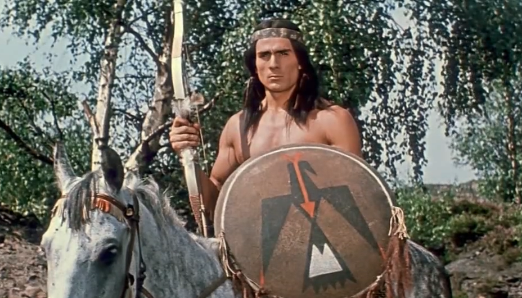
Frame from the movie "Sons of the Big Dipper" (1966). Tokei Ito with an eagle shield
who brandished a Spanish spear
and covered his chest with a large shield,
adorned with eagle feathers.
Several arrows pierced his shield.
I took aim, pulled the string with all my might, and fired.
The arrow went deep into his neck.
He dropped his spear and shield
and grasped the shaft of an arrow with both hands,
trying to get her out.
Bernard Schulz "Son of the Navajos"
Indians with and without tomahawks. The shield is the oldest type of protection of one person from an attack by another. At first it was a parrying stick with a through handle, which was used to beat off a flying spear, but then people thought of attaching some kind of flat surface to it that could stop the enemy weapon.
A variety of materials were used to make shields, most often associated with local conditions. The shields were woven from rods, in the manner of the bottom of a basket, only larger, and the rods were intertwined in several rows. A very popular means of protection were shields made of wood, metal, leather. The latter were widely distributed throughout the world, for example, they were found in England, and in other places.
So the American Indians also used leather shields - quite light and durable. In addition, they always had the material for their manufacture at hand. That is, with the Indians everything was exactly the same as with other nomadic peoples - horse archers. All of them simply needed a shield, and it had to have a round shape so that it would be convenient to carry it behind the back, and not interfere with the horse archer using the bow!
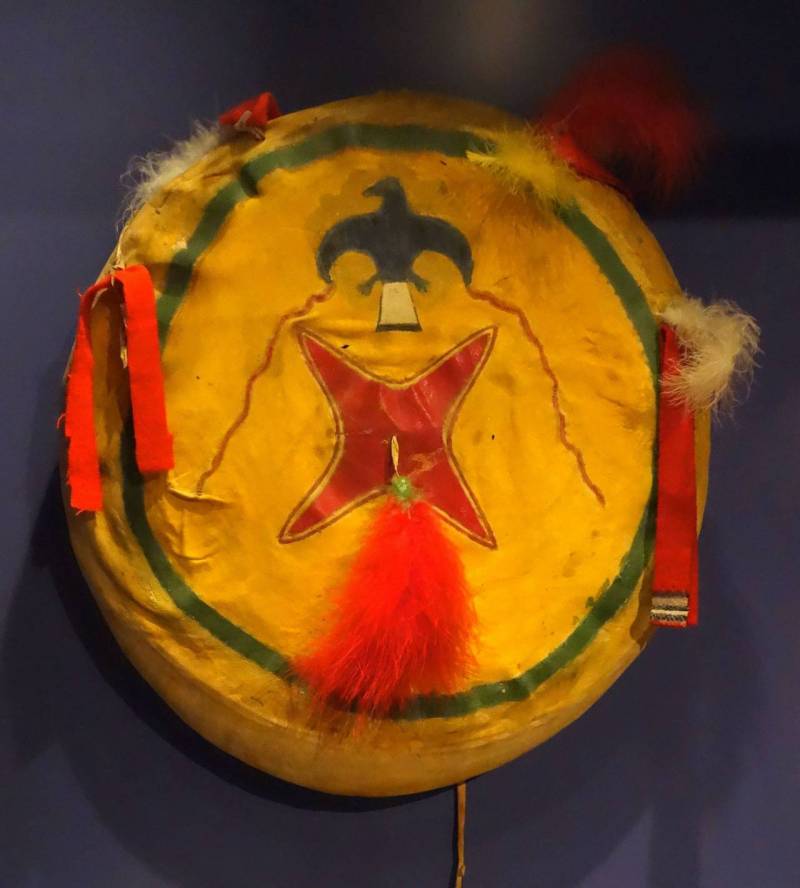
Shield of the Sioux Indians with the image of a pointed cross symbol of the four cardinal points. Glenbow Museum, Calgary, Alberta, Canada
It was easiest to make such a shield out of leather, and for this, the Prairie Indians also had everything at hand. In particular, the processed skin of a bison was an ideal material for the manufacture of such a shield. Moreover, it was with the shield that the Indians had a lot of rituals, beliefs and customs, since the shield was their main means of protection. An Indian youth could not become a warrior until he had a shield. But the Indian could not make shields in unlimited quantities either. No more than four in a lifetime - that was the rule, so the loss of a shield was seen as the greatest misfortune.
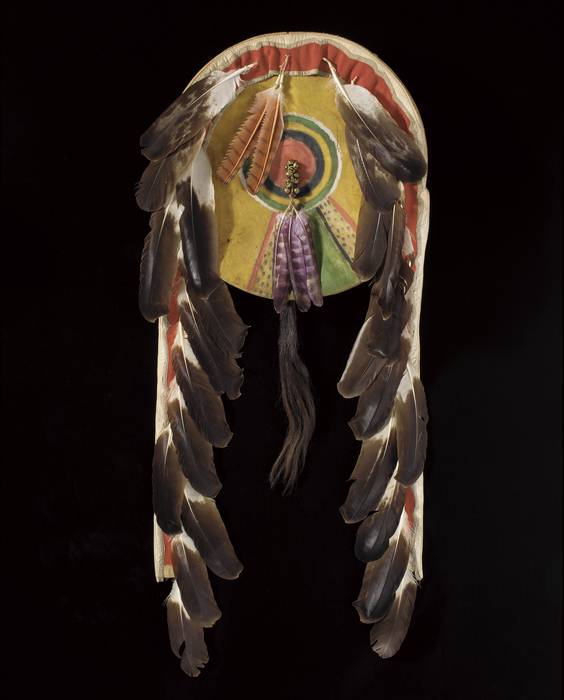
Osage Shield, 50 cm in diameter. Glenbow Museum, Calgary, Alberta, Canada
First of all, in order to make a shield, the young Indian had to kill an old male buffalo, since he had the most durable skin.
He had to make the shield himself, but he could also ask the shaman to make his magical power more reliable. The manufacturing technology was simple, but it required skill. First, a hole was dug in the ground, stones were placed in it and a strong fire was kindled on them so that they would be properly heated. Over the hot stones they stretched the buffalo skin with its thickest part, which was located in the area of the withers, and poured water on these stones. Hot steam thickened the skin, and it became even stronger.
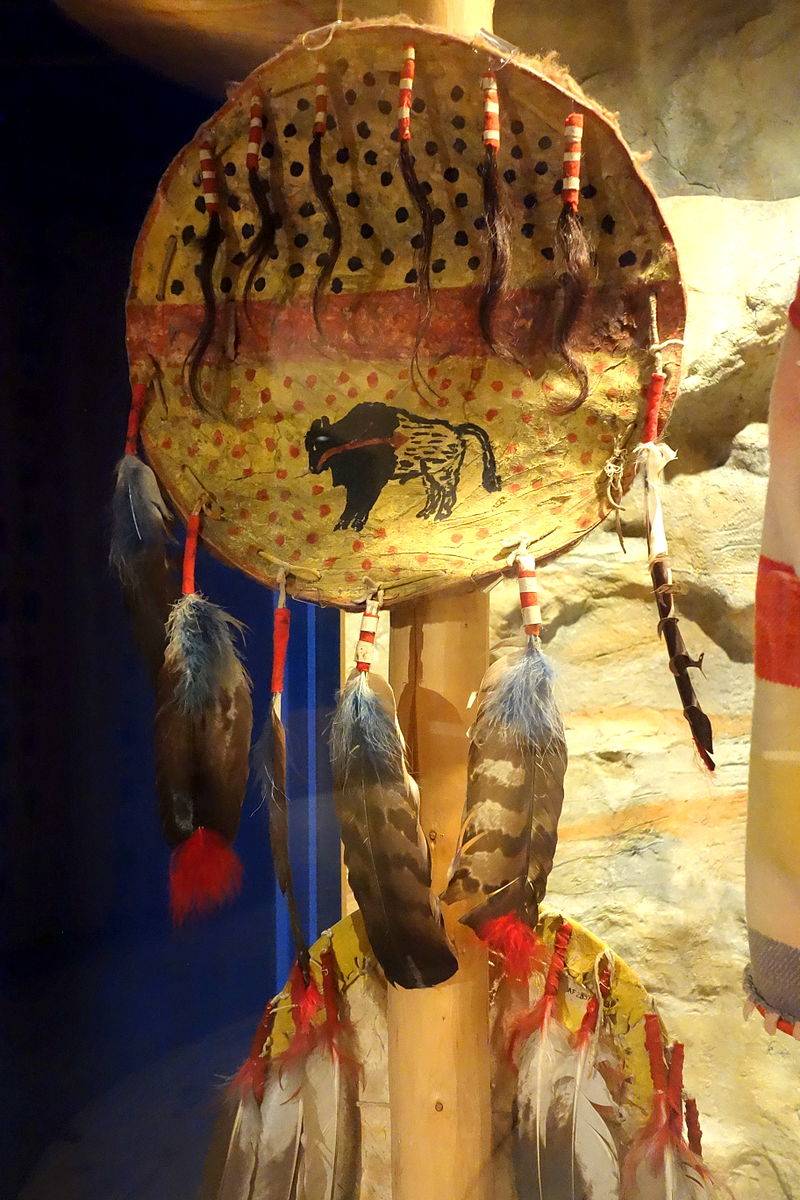
Shield of the Siksiks ("Blackfoot"). Glenbow Museum, Calgary, Alberta, Canada
After that, the wool was removed from it and a circle of the future shield was cut out. Usually it was about 50 cm in diameter or a little more. All folds were smoothed out with flat stones on the skin and, if necessary, one layer of skin was glued with hoof glue on the second.
The thickness of many shields that have survived to this day is about 5 cm, that is, they were usually glued together, because even the so-called “plantar skin” does not have such a thickness. However, Indian shields were also thick because they had a close-fitting of thinner antelope or deer skin, and bison hair or eagle feathers were stuffed into the resulting space, which, according to the Indians, increased the protective qualities of the shield.
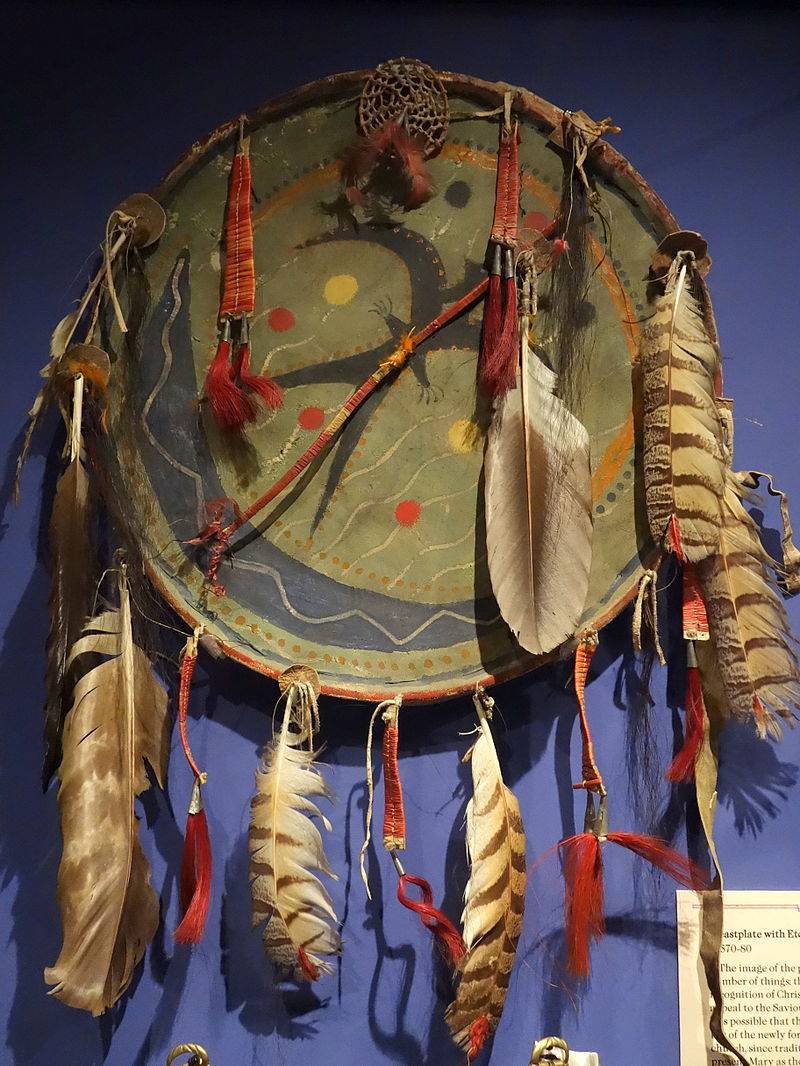
Sioux shield with thunderbird and moon, late XNUMXth century, decorated with feathers, horsehair, porcupine quills and metal knobs. Glenbow Museum, Calgary, Alberta, Canada
Now the shield had to be finished, and here was the most work. To do this, they invited the most famous warriors who, before starting work, smoked Sacred pipes and sang songs, that is, they worked in good conscience!
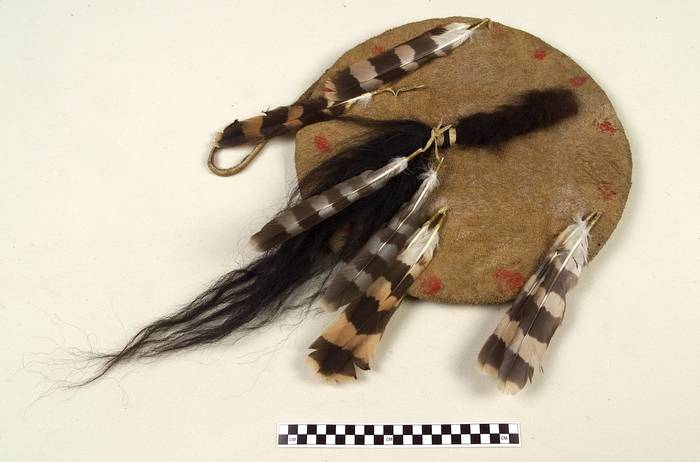
Shield of the Cheyenne. National Museum of the American Indians, Washington
The images on the shield were almost as important as the main body of the shield. Sacred symbols should have been depicted: the Sun, the Moon, the Thunder Bird, as well as all kinds of animals with power. In addition to drawings, the shield could be decorated with feathers of a military eagle, swallows, stuffed small animals, claws of a grizzly bear or a “mountain lion” (puma), stripes of colored cloth, bags of “medicines” (magic amulets) - the Indians’ imagination here was simply limitless.
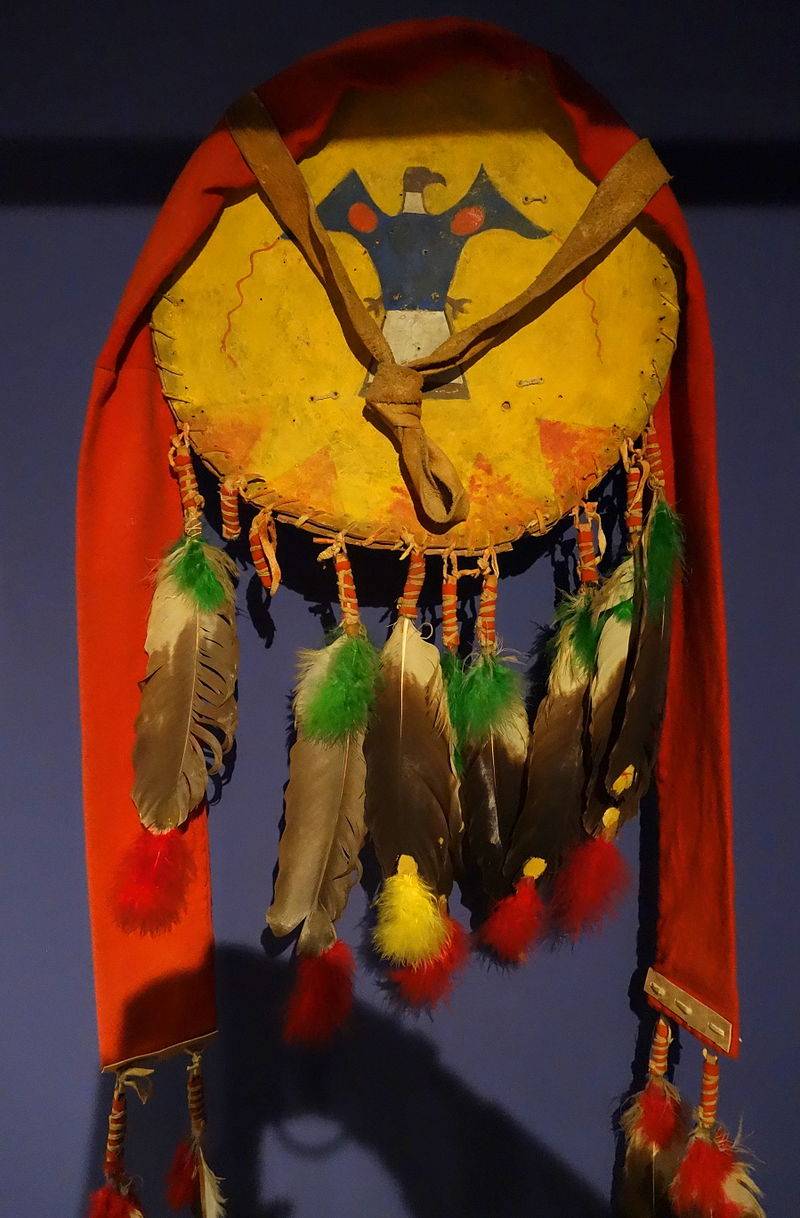
Dakota shield, late XNUMXth century. Rawhide, feathers, red wool. Glenbow Museum, Calgary, Alberta, Canada
Images of animals and birds were highly ritualized. For example, the Thunder Bird was supposed to have a white belly and a black back. And in order to draw her, it was necessary to bring her a gift of tobacco, that is, to smoke the Sacred Pipe in her honor. In addition to the shield, he should have sewn a tire and also decorated it accordingly. During the day, the shield was taken out of it and hung on a tripod near the tipi, facing the sun, and by night they put on the tire again and took it to the dwelling to “sleep”. The shield was not supposed to touch the ground. It was believed that if this happened, then all the magical power would leave him.
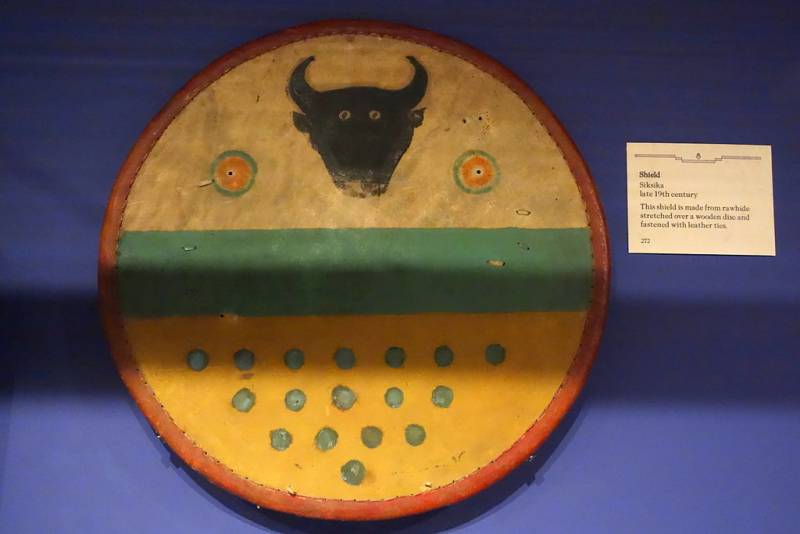
Shield of the Siksiks, late XNUMXth century. Rawhide over a wooden disc! Glenbow Museum, Calgary, Alberta, Canada
By the way, it was magic that underlay the so-called "spider shields". Most of all, these shields resembled the well-known "dream catcher" - the same hoop, inside of which there is a complex weaving of thin leather straps, and ... that's it! It was believed that such a shield would not miss a bullet or an arrow. What this naive belief was based on is not entirely clear. In any case, the Indians had few such shields. For example, there are only four for the entire Dakota tribe!
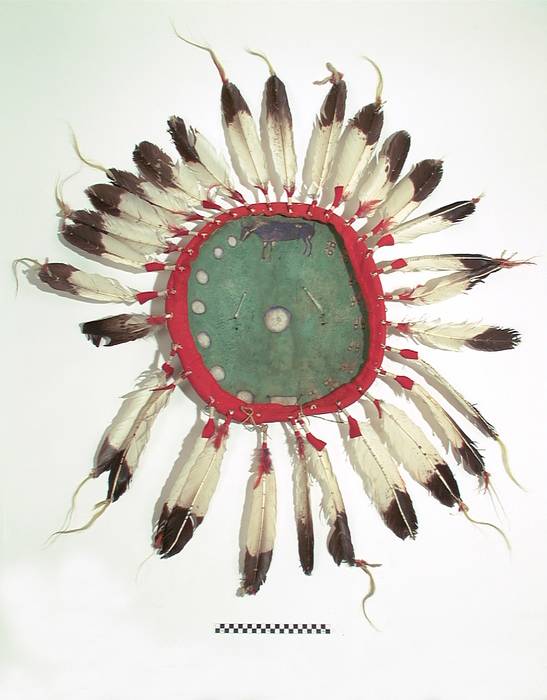
Battle shield of the Sik-siks ("Blackfoot") 1875. Diameter 54 cm. National Museum of the American Indians, Washington
It is interesting that the Indians were not limited to combat shields. Shields were also made by women, and these were the so-called dance shields, with which various dances were performed. They were decorated even more richly than combat ones, but at the same time they were much lighter. Usually it was a wicker hoop, which was covered with deer skin. There were different shields for different dances. For example, in order to cause rain, it was necessary to arrange a dance in honor of the same Thunder Bird, which means that its image had to decorate the shields of the dancers. "Buffalo dance" demanded shields with the image of bison...
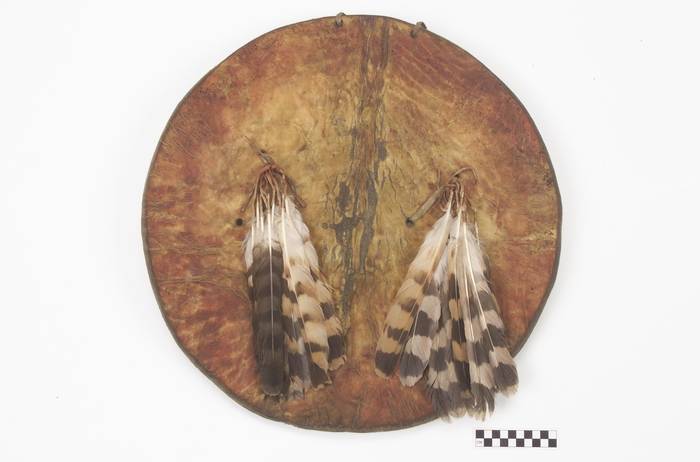
Shield of the Gros Ventre, diameter 54 cm. 1860 National Museum of the American Indians, Washington
However, this was not all.
The Indians also had special “healing” or “healing shields”. They were made in order to cure the patient, protecting him with a shield from the bad influence of evil spirits. The contour of such a shield marked the border that protected its owner from everything that he considered undesirable for himself. But the images inside spoke of what he himself was.
Therefore, another person often made it, so that selfishness would not interfere with reflecting the truth on him. Lying about one's own abilities was a serious sin and could lead to expulsion from the tribe. Shields, carrying false information, were usually burned.
In the same way, medical shields were made for themselves by women. They also had to reflect their abilities in them, so that the “healing shield” was a kind of Indian passport.
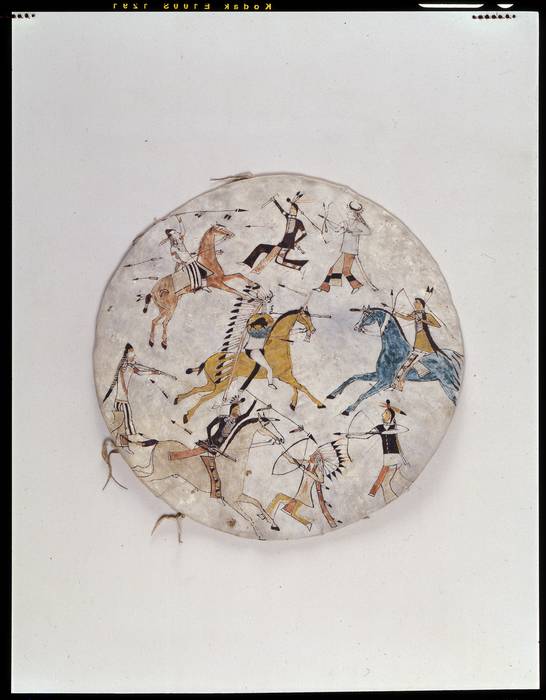
Shield depicting the military exploits of Chief Gorb (Etokea, c. 1848–1908). Dakota. National Museum of the American Indians, Washington
But what the colors symbolized in which the shield was painted. Blue is the cedar that grows in the sacred mountains. Green is the innocence of the heart. Red - symbolized fire and strength of mind. Yellow is the eagle of the East, so that a person can see, like an eagle, far away. Black otter fur and white mink were signs of wisdom and healing power.
And also that adults, like children, should frolic in the water, since it also has healing powers. The image of crescents with horns to each other is a symbol of the person himself and the duality of his nature. The dark crescent - fear and joy, the light one symbolized the actual person of the owner of the shield when the sun illuminates it. Such, for example, was the meaning of flowers in the Sioux Dakota tribe. In other tribes, it could differ, and quite strongly.
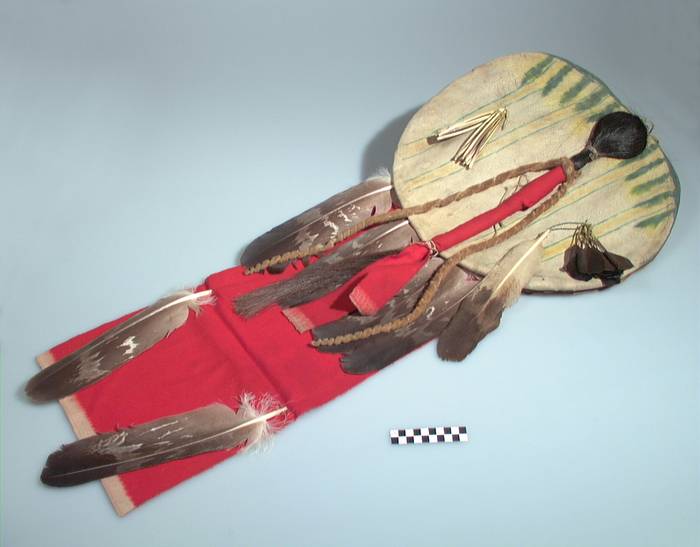
Kiowa dance shield. National Museum of the American Indians, Washington
Thus, the shield in the Indian family was far from alone, and it did not always belong to a man. However, in any case, the significance of the shield in Indian culture (precisely because the shields belonged to both men and women) is exceptionally great. Only the Sacred Headdress, the Sacred Pipe and the Scalp Shirt were of equal importance.
Information